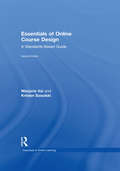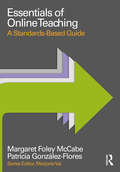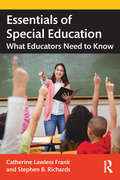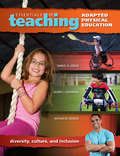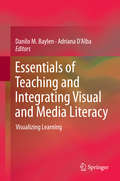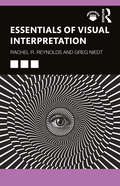- Table View
- List View
Essentials of Literacy from 0-7: A Whole-Child Approach to Communication, Language and Literacy
by Ms Jenny Spratt Professor Tina BruceChildren flourish in their development and learning when practitioners and parents work together. Childrens' development and learning are further enhanced when interconnected knowledge and understanding work together. In this new edition the authors guide readers in understanding of child development. They highlight the need for those who work with young children to become reflective practitioners. Through a focus on the introduction of nursery rhymes, finger rhymes, action songs and poetry cards, the authors provide a gentle, child-friendly way to develop literacy 0-7. Thoroughly revised and updated, this book includes: - Case studies and examples - Discussion of the primary framework - Inclusion of schools as an educational setting - Age-appropriate activities - Further reading suggestions at the end of each chapter This book is useful for teachers, practitioners, teaching assistants and childminders and for anyone working with children from birth to seven years in nursery and primary schools, children's centres, foundation units, and at home. Tina Bruce is an Honorary visiting professor in Early Childhood at Roehampton University. Jenny Spratt is Head of EYFS and Children's Centre Services for Peterborough Local Authority
Essentials of Middle and Secondary Social Studies
by William B. Russell III Stewart Waters Thomas N. TurnerBuilding on the success of a much-loved elementary text, Essentials of Middle and Secondary Social Studies focuses on the key issues central to the actual teaching of middle and high school social studies, including lesson planning and inclusive instructional strategies. Written in an engaging, conversational style, the text encourages teachers in their development as professionals and enables them to effectively use creative and active learning strategies in the everyday classroom. Features of the book include: • A full chapter on lesson plans designed to provide middle and secondary social studies teachers with classroom tested lesson plans. The chapter includes two classroom tested lessons for each social science discipline---U.S. History, World History, Geography, Government, Economics, Psychology, & Sociology. • A chapter on technology that is designed to better prepare middle and secondary social studies teachers to effectively teach social studies with technology. Attention is given to digital history, media literacy, teaching with film and music, and numerous other types of impactful technology.• Each teaching methodology and lesson plan discusses how the strategy can be used to meet the individual needs of diverse learners, including English Language Learners and exceptional education students. • A section in each chapter provides various resources for further development. The section includes articles, books, and web resources. • Each chapter includes an “Extension” activity offering readers with the opportunity to extend the learning experience with relevant and meaningful real-life scenarios. • “Focus activities” give readers the opportunity to prepare for the learning experience with relevant and meaningful scenarios. • Covers current topics such as NCSS Standards, Common Core State Standards, Technology, Media, Skills, Character Education, and Literacy.
Essentials of Middle and Secondary Social Studies
by William B. Russell III Stewart Waters Thomas N. TurnerBuilding on the success of a much-loved elementary text, Essentials of Middle and Secondary Social Studies focuses on the key issues central to the actual teaching of middle and high school social studies, including lesson planning and inclusive instructional strategies. Written in an engaging, conversational style, the text encourages teachers in their development as professionals and enables them to effectively use creative and active learning strategies in the everyday classroom. Features of the book include: • A full chapter on lesson plans designed to provide middle and secondary social studies teachers with classroom tested lesson plans. The chapter includes two classroom tested lessons for each social science discipline---U.S. History, World History, Geography, Government, Economics, Psychology, & Sociology. • A chapter on technology that is designed to better prepare middle and secondary social studies teachers to effectively teach social studies with technology. Attention is given to digital history, media literacy, teaching with film and music, and numerous other types of impactful technology.• Each teaching methodology and lesson plan discusses how the strategy can be used to meet the individual needs of diverse learners, including English Language Learners and exceptional education students. • A section in each chapter provides various resources for further development. The section includes articles, books, and web resources. • Each chapter includes an “Extension” activity offering readers with the opportunity to extend the learning experience with relevant and meaningful real-life scenarios. • “Focus activities” give readers the opportunity to prepare for the learning experience with relevant and meaningful scenarios. • Covers current topics such as NCSS Standards, Common Core State Standards, Technology, Media, Skills, Character Education, and Literacy.
Essentials of Middle and Secondary Social Studies
by William B. Russell III Stewart Waters Thomas N. TurnerBuilding on the success of the first edition, Essentials of Middle and Secondary Social Studies 2nd Edition focuses on the key issues central to the teaching of middle and high school social studies, including lesson planning and instructional strategies. Written in an engaging, conversational style, the text encourages teachers in their development as professionals and enables them to effectively use creative and active learning strategies in the everyday classroom. NEW TO THIS EDITION This second edition has been significantly refined with new and relevant topics and strategies needed for effectively teaching middle and secondary social studies. New features include: An updated chapter on lesson plans, in keeping with the book’s emphasis on planning and teaching. This chapter is designed to provide middle and secondary teachers with new classroom-tested lesson plans and includes two classroom-tested lessons for each grade level (6-12). An expanded chapter on planning. This chapter provides additional discussion about long-range planning and includes examples of lesson plans with details to help students be better prepared. An updated chapter on technology designed to better prepare middle and secondary teachers to effectively incorporate technology into social studies instruction. Attention is given to digital history, media literacy, teaching with film and music, popular apps and numerous other types of impactful technology. "FYI" callouts throughout each chapter. These callouts provide helpful information and further explanation. An expanded discussion of the Common Core Standards and C3 Framework and how they impact teachers. An updated chapter titled "Experiencing Social Studies." This chapter focuses on topics such as teaching with drama, role play, field trips, and service learning. A "Helpful Resources" section that details various websites and online resources for further discovery.
Essentials of Middle and Secondary Social Studies
by William B. Russell III Stewart Waters Thomas N. TurnerBuilding on the success of the first edition, Essentials of Middle and Secondary Social Studies 2nd Edition focuses on the key issues central to the teaching of middle and high school social studies, including lesson planning and instructional strategies. Written in an engaging, conversational style, the text encourages teachers in their development as professionals and enables them to effectively use creative and active learning strategies in the everyday classroom. NEW TO THIS EDITION This second edition has been significantly refined with new and relevant topics and strategies needed for effectively teaching middle and secondary social studies. New features include: An updated chapter on lesson plans, in keeping with the book’s emphasis on planning and teaching. This chapter is designed to provide middle and secondary teachers with new classroom-tested lesson plans and includes two classroom-tested lessons for each grade level (6-12). An expanded chapter on planning. This chapter provides additional discussion about long-range planning and includes examples of lesson plans with details to help students be better prepared. An updated chapter on technology designed to better prepare middle and secondary teachers to effectively incorporate technology into social studies instruction. Attention is given to digital history, media literacy, teaching with film and music, popular apps and numerous other types of impactful technology. "FYI" callouts throughout each chapter. These callouts provide helpful information and further explanation. An expanded discussion of the Common Core Standards and C3 Framework and how they impact teachers. An updated chapter titled "Experiencing Social Studies." This chapter focuses on topics such as teaching with drama, role play, field trips, and service learning. A "Helpful Resources" section that details various websites and online resources for further discovery.
Essentials of Middle and Secondary Social Studies
by Stewart Waters William B. Russell IIIBuilding on the success of the previous editions, Essentials of Middle and Secondary Social Studies Third Edition focuses on the key issues central to the teaching of middle and high school social studies, including lesson planning and instructional strategies. Written in an engaging, conversational style, the text encourages teachers in their development as professionals and enables them to effectively use creative and active learning strategies in the everyday classroom. New to This Edition This third edition has been refined with new and relevant topics and strategies needed for effectively teaching middle and high school social studies. New features include: An expanded chapter on the decision-making process in secondary social studies. This chapter provides additional discussion about the importance of helping middle and high school learners better understand the decision-making process and offers strategies for helping teachers make connections between choices, values, character development, and social justice. An updated chapter on technology designed to better prepare secondary social studies teachers to effectively incorporate technology into their instruction. Focus is given to virtual teaching and learning, media literacy, teaching with film, and numerous other ways to improve teaching and learning in the digital age. Updated further readings and helpful resources for all chapters to include supplemental digital and video sources related to various topics throughout the chapter. These resources were specifically curated to be impactful for preservice and in-service teachers, as well as anyone teaching secondary social studies methods courses. Added a "Checking for Understanding" section of questions at the end of each chapter that focuses on comprehension, application, and reflection on key concepts throughout the chapters. An expanded discussion of the Common Core Standards and C3 Framework and how it impacts teachers. An updated chapter titled "Experiencing Social Studies". This chapter focus on topics such as teaching with drama, role play, field trips, and service learning. Each chapter includes a "Helpful Resources" section that details various websites and online resources for further discovery.
Essentials of Middle and Secondary Social Studies
by Stewart Waters William B. Russell IIIBuilding on the success of the previous editions, Essentials of Middle and Secondary Social Studies Third Edition focuses on the key issues central to the teaching of middle and high school social studies, including lesson planning and instructional strategies. Written in an engaging, conversational style, the text encourages teachers in their development as professionals and enables them to effectively use creative and active learning strategies in the everyday classroom. New to This Edition This third edition has been refined with new and relevant topics and strategies needed for effectively teaching middle and high school social studies. New features include: An expanded chapter on the decision-making process in secondary social studies. This chapter provides additional discussion about the importance of helping middle and high school learners better understand the decision-making process and offers strategies for helping teachers make connections between choices, values, character development, and social justice. An updated chapter on technology designed to better prepare secondary social studies teachers to effectively incorporate technology into their instruction. Focus is given to virtual teaching and learning, media literacy, teaching with film, and numerous other ways to improve teaching and learning in the digital age. Updated further readings and helpful resources for all chapters to include supplemental digital and video sources related to various topics throughout the chapter. These resources were specifically curated to be impactful for preservice and in-service teachers, as well as anyone teaching secondary social studies methods courses. Added a "Checking for Understanding" section of questions at the end of each chapter that focuses on comprehension, application, and reflection on key concepts throughout the chapters. An expanded discussion of the Common Core Standards and C3 Framework and how it impacts teachers. An updated chapter titled "Experiencing Social Studies". This chapter focus on topics such as teaching with drama, role play, field trips, and service learning. Each chapter includes a "Helpful Resources" section that details various websites and online resources for further discovery.
Essentials of Online Course Design: A Standards-Based Guide (Essentials of Online Learning)
by Marjorie Vai Kristen SosulskiIn spite of the proliferation of online learning, creating online courses can still evoke a good deal of frustration, negativity, and wariness in those who need to create them. The second edition of Essentials of Online Course Design takes a fresh, thoughtfully designed, step-by-step approach to online course development. At its core is a set of standards that are based on best practices in the field of online learning and teaching. Pedagogical, organizational, and visual design principles are presented and modeled throughout the book, and users will quickly learn from the guide’s hands-on approach. The course design process begins with the elements of a classroom syllabus which, after a series of guided steps, easily evolve into an online course outline. The guide’s key features include: a practical approach informed by theory clean interior design that offers straightforward guidance from page one clear and jargon-free language examples, screenshots, and illustrations to clarify and support the text a checklist of online course design standards that readers can use to self-evaluate. a Companion Website with examples, adaptable templates, interactive learning features, and online resources: http://essentialsofonlinecoursedesign.com Essentials of Online Course Design serves as a best practice model for designing online courses. After reading this book, readers will find that preparing for online teaching is a satisfying and engaging experience. The core issue is simply good design: pedagogical, organizational, and visual. For more of Marjorie Vai in her own words, listen to this 2011 interview from the On Teaching Online podcast: http://onteachingonline.com/oto-16-essentials-of-online-course-design-with-marjorie-vai/
Essentials of Online Course Design: A Standards-Based Guide (Essentials of Online Learning)
by Marjorie Vai Kristen SosulskiIn spite of the proliferation of online learning, creating online courses can still evoke a good deal of frustration, negativity, and wariness in those who need to create them. The second edition of Essentials of Online Course Design takes a fresh, thoughtfully designed, step-by-step approach to online course development. At its core is a set of standards that are based on best practices in the field of online learning and teaching. Pedagogical, organizational, and visual design principles are presented and modeled throughout the book, and users will quickly learn from the guide’s hands-on approach. The course design process begins with the elements of a classroom syllabus which, after a series of guided steps, easily evolve into an online course outline. The guide’s key features include: a practical approach informed by theory clean interior design that offers straightforward guidance from page one clear and jargon-free language examples, screenshots, and illustrations to clarify and support the text a checklist of online course design standards that readers can use to self-evaluate. a Companion Website with examples, adaptable templates, interactive learning features, and online resources: http://essentialsofonlinecoursedesign.com Essentials of Online Course Design serves as a best practice model for designing online courses. After reading this book, readers will find that preparing for online teaching is a satisfying and engaging experience. The core issue is simply good design: pedagogical, organizational, and visual. For more of Marjorie Vai in her own words, listen to this 2011 interview from the On Teaching Online podcast: http://onteachingonline.com/oto-16-essentials-of-online-course-design-with-marjorie-vai/
Essentials of Online Teaching: A Standards-Based Guide (Essentials of Online Learning)
by Margaret Foley McCabe Patricia González-FloresTeachers’ active online participation and engagement with students are critical factors to the success of online courses. Essentials of Online Teaching is a standards-based, straightforward guide to teaching online in higher education, high school and vocational training, or corporate learning environments. This brief but powerful book encourages immediate application of concepts with the help of real-world examples, technical insights, and professional advice. The guide includes: a practical approach informed by, but not about, relevant learning theories; clear models and examples from a wide variety of online courses; teachers’ reflections about their online practice; a checklist of standards to help guide teaching decisions; and an accompanying website (www.essentialsofonlineteaching.com) with additional resources. Essentials of Online Teaching addresses key instructional challenges in online teaching and presents the reader with practical solutions for each phase of a course—preparation, beginning, middle, and end.
Essentials of Online Teaching: A Standards-Based Guide (Essentials of Online Learning)
by Margaret Foley McCabe Patricia González-FloresTeachers’ active online participation and engagement with students are critical factors to the success of online courses. Essentials of Online Teaching is a standards-based, straightforward guide to teaching online in higher education, high school and vocational training, or corporate learning environments. This brief but powerful book encourages immediate application of concepts with the help of real-world examples, technical insights, and professional advice. The guide includes: a practical approach informed by, but not about, relevant learning theories; clear models and examples from a wide variety of online courses; teachers’ reflections about their online practice; a checklist of standards to help guide teaching decisions; and an accompanying website (www.essentialsofonlineteaching.com) with additional resources. Essentials of Online Teaching addresses key instructional challenges in online teaching and presents the reader with practical solutions for each phase of a course—preparation, beginning, middle, and end.
Essentials of Qualitatively-Driven Mixed-Method Designs (Qualitative Essentials)
by Janice M. MorseIn a mixed-method tradition that privileges the quantitative, leading qualitative researcher Janice Morse breaks new ground by arguing the importance of research designs for which the primary component is qualitative, and contains either a quantitative or a qualitative supplemental strategy. Using a variety of examples and visual prompts, Morse convincingly demonstrates that such designs allow novice researchers to obtain answers more quickly and with more certainty. Her book provides clear and concise explanations making even complex research designs understandable to the beginning researcher; argues for the importance of primary qualitative designs due to their theoretical strength; stresses the importance of using goal-directed actions and analyses that do not violate the assumptions of either qualitative or quantitative inquiry.
Essentials of Qualitatively-Driven Mixed-Method Designs (Qualitative Essentials #14)
by Janice M. MorseIn a mixed-method tradition that privileges the quantitative, leading qualitative researcher Janice Morse breaks new ground by arguing the importance of research designs for which the primary component is qualitative, and contains either a quantitative or a qualitative supplemental strategy. Using a variety of examples and visual prompts, Morse convincingly demonstrates that such designs allow novice researchers to obtain answers more quickly and with more certainty. Her book provides clear and concise explanations making even complex research designs understandable to the beginning researcher; argues for the importance of primary qualitative designs due to their theoretical strength; stresses the importance of using goal-directed actions and analyses that do not violate the assumptions of either qualitative or quantitative inquiry.
Essentials of Radiology E-Book
by Fred A. Mettler Jr.Take image interpreting one step at a time with Essentials of Radiology, the most accessible radiology text on the market for gaining a foothold on the fundamentals. Breathe easy - this reference assumes no prior knowledge of radiology, making it the perfect choice for anyone just starting out in the field. Whether you're a student or resident, you'll appreciate how expert radiologist, Dr. Mettler, masterfully distills all the information you need, in precisely the right way.Gain a rich understanding of recent advances in the diagnostic imaging of abdominal, pelvic, and retroperitoneal conditions, and take advantage of this text's sharp focus on the most common pathologic entities and rarer life-threatening conditions.Explore the radiologic evaluation of headaches, hypertension, low back pain, and other challenging conditions.
Essentials of Research Methods in Education
by Scott Buckler Harriett MooreThis book provides a comprehensive overview of research methods, supported by examples from a range of educational fields, along with pragmatic advice and guidance on how to undertake educational research. Using the concept of research as a ‘quest’, this book takes you on a journey from planning stages, through data collection to analysis, to writing up your findings, at each stage exploring the principles and practice that can support your own educational research projects. Academic understanding is combined with practical commentary to show how conceptual ideas are used in practice. Case studies throughout the book highlight the power of educational research to shine a light on important social issues. This is essential reading for students on all education courses that include a research methods module or project. Scott Buckler PhD is an independent academic, Chartered Teacher and Chartered Psychologist. Harriett Moore is a school-based practitioner with a broad background in research.
Essentials of Research Methods in Education
by Scott Buckler Harriett MooreThis book provides a comprehensive overview of research methods, supported by examples from a range of educational fields, along with pragmatic advice and guidance on how to undertake educational research. Using the concept of research as a ‘quest’, this book takes you on a journey from planning stages, through data collection to analysis, to writing up your findings, at each stage exploring the principles and practice that can support your own educational research projects. Academic understanding is combined with practical commentary to show how conceptual ideas are used in practice. Case studies throughout the book highlight the power of educational research to shine a light on important social issues. This is essential reading for students on all education courses that include a research methods module or project. Scott Buckler PhD is an independent academic, Chartered Teacher and Chartered Psychologist. Harriett Moore is a school-based practitioner with a broad background in research.
Essentials of Research Methods in Education
by Scott Buckler Harriett MooreThis book provides a comprehensive overview of research methods, supported by examples from a range of educational fields, along with pragmatic advice and guidance on how to undertake educational research. Using the concept of research as a ‘quest’, this book takes you on a journey from planning stages, through data collection to analysis, to writing up your findings, at each stage exploring the principles and practice that can support your own educational research projects. Academic understanding is combined with practical commentary to show how conceptual ideas are used in practice. Case studies throughout the book highlight the power of educational research to shine a light on important social issues. This is essential reading for students on all education courses that include a research methods module or project. Scott Buckler PhD is an independent academic, Chartered Teacher and Chartered Psychologist. Harriett Moore is a school-based practitioner with a broad background in research.
Essentials of Special Education: What Educators Need to Know
by Catherine Lawless Frank Stephen B. RichardsIn this succinct yet comprehensive text, authors Lawless Frank and Richards guide readers through the essential basics that every educator needs to know about special education, covering everything from law to application. Streamlined and accessible chapters address legal knowledge – Section 504, IDEA, ESSA, and FERPA — assessment and identification, RTI, categories of disability, IEPs, accommodations, co-teaching, and instructional considerations. Designed to give new educators a focused introduction to critical concepts and terminology, this book also features supplemental online resources including an Instructor’s Manual, quizzes, and more.
Essentials of Special Education: What Educators Need to Know
by Catherine Lawless Frank Stephen B. RichardsIn this succinct yet comprehensive text, authors Lawless Frank and Richards guide readers through the essential basics that every educator needs to know about special education, covering everything from law to application. Streamlined and accessible chapters address legal knowledge – Section 504, IDEA, ESSA, and FERPA — assessment and identification, RTI, categories of disability, IEPs, accommodations, co-teaching, and instructional considerations. Designed to give new educators a focused introduction to critical concepts and terminology, this book also features supplemental online resources including an Instructor’s Manual, quizzes, and more.
Essentials of Teaching Adapted Physical Education: Diversity, Culture, and Inclusion
by Samuel Hodge Lauren Lieberman Nathan MurataEssentials of Teaching Adapted Physical Education: Diversity, Culture, and Inclusion offers a wealth of knowledge for teaching today's diverse student population, including those with disabilities. Readers will learn how to teach a variety of students, organize learning within various curricular models, assess and evaluate students, and manage behavior. Readers will also learn more about the conditions and disabilities they may encounter when teaching, how to understand students' various abilities, and how to adapt and modify instructional methods to include all students.The book emphasizes the importance of being culturally responsive and acquiring the necessary knowledge to infuse appropriate, socially just practices into educational settings. Future teachers will learn how to apply culturally responsive instructional methods and behavior management strategies and will understand broader social and economic contexts for their students' behavior.At the same time, this book provides more than a how-to approach to teaching adapted physical education. Its content and features promote reflective learning, encouraging readers to anticipate the types of teaching situations and challenges that may arise and think through how they will respond. Scenarios and vignettes throughout provide context for the material and promote critical thinking and problem solving.
Essentials of Teaching Adapted Physical Education: Diversity, Culture, and Inclusion
by Samuel Hodge Lauren Lieberman Nathan MurataEssentials of Teaching Adapted Physical Education: Diversity, Culture, and Inclusion offers a wealth of knowledge for teaching today's diverse student population, including those with disabilities. Readers will learn how to teach a variety of students, organize learning within various curricular models, assess and evaluate students, and manage behavior. Readers will also learn more about the conditions and disabilities they may encounter when teaching, how to understand students' various abilities, and how to adapt and modify instructional methods to include all students.The book emphasizes the importance of being culturally responsive and acquiring the necessary knowledge to infuse appropriate, socially just practices into educational settings. Future teachers will learn how to apply culturally responsive instructional methods and behavior management strategies and will understand broader social and economic contexts for their students' behavior.At the same time, this book provides more than a how-to approach to teaching adapted physical education. Its content and features promote reflective learning, encouraging readers to anticipate the types of teaching situations and challenges that may arise and think through how they will respond. Scenarios and vignettes throughout provide context for the material and promote critical thinking and problem solving.
Essentials of Teaching and Integrating Visual and Media Literacy: Visualizing Learning
by Danilo M. Baylen Adriana D’AlbaThis book focuses on how to effectively integrate the teaching and learning of visual and media literacies in K-12 and higher education. Not only does it address and review the elements and principles of visual design but also identifies, discusses and describes the value of media in learning diverse and challenging content across disciplines. Finally, this book provides a balanced treatment of how visual and media literacies support deep content learning, student engagement, critical thinking, creativity, problem solving, and production.
Essentials of the New Science of Learning: The Power of Learning in Harmony With Your Brain
by Todd D. ZakrajsekThis streamlined adaption of the best-selling book The New Science of Learning: How to Learn in Harmony with Your Brain is a distillation of the most essential and immediately effective tips and strategies selected specifically to put college students on the path to success.In this primer, Zakrajsek masterfully translates complex findings from cognitive psychology and neuroscience into easy-to-understand concepts that can be used immediately to learn faster and retain information longer. Readers will come away with strategies that have been demonstrated throughout the world to improve learning, as well as a greatly enhanced understanding of how the learning process works. Taking just a few hours to read the material in this book and practice what has been assembled for learners at any level may well prove to be one of the best decisions a college student can make.Essentials of the New Science of Learning: The Power of Learning in Harmony With Your Brain is ideal for individual student use or as a powerful supplement to any course, in any course, across the college curriculum.
Essentials of the New Science of Learning: The Power of Learning in Harmony With Your Brain
by Todd D. ZakrajsekThis streamlined adaption of the best-selling book The New Science of Learning: How to Learn in Harmony with Your Brain is a distillation of the most essential and immediately effective tips and strategies selected specifically to put college students on the path to success.In this primer, Zakrajsek masterfully translates complex findings from cognitive psychology and neuroscience into easy-to-understand concepts that can be used immediately to learn faster and retain information longer. Readers will come away with strategies that have been demonstrated throughout the world to improve learning, as well as a greatly enhanced understanding of how the learning process works. Taking just a few hours to read the material in this book and practice what has been assembled for learners at any level may well prove to be one of the best decisions a college student can make.Essentials of the New Science of Learning: The Power of Learning in Harmony With Your Brain is ideal for individual student use or as a powerful supplement to any course, in any course, across the college curriculum.
Essentials of Visual Interpretation
by Rachel R Reynolds Greg NiedtEssentials of Visual Interpretation explains how to talk and write critically about visual media and to examine how evolving visual environments, media, and technologies affect human selfunderstanding and culture formation.Lively and accessibly written chapters provide a solid foundation in the tools and ideas of visual meaning, familiarizing readers with a growing, cross-cultural subfield, and preparing them to pursue thoughtful work in a variety of related disciplines. The authors include rich examples and illustrations—ranging from cave paintings to memes, from optical science to visual analytics, from ancient pictographs to smart phones—that engage students with the fascinating complexity of visual interpretation. Each chapter introduces students to key terms and concepts relevant to visual analysis, with ideas for short individual or group exercises to enhance understanding.The book is ideal as a primer in visual analysis and visual communication for students in courses within communication studies, cultural studies, digital humanities, semiotics, media studies, and visual anthropology.Online support materials include multimedia activities for students and links to additional resources for students and instructors.




